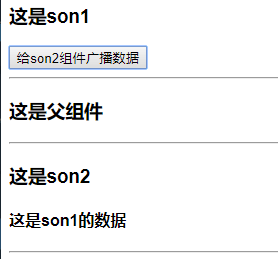1)利用父子组件是实现非父子组件传值
2) 通过事件广播实现非父组件的传值
- 新建一个js文件
VueEvent.js,在该文件中引入vue,实例化vue,暴露该实例 - 在要广播(即要传送数据)和接收数据的地方都要引入该实例
- 通过
VueEvent.$emit('名称','数据') - 接收数据的地方用
$on
VueEvent.$on('名称',(data)=>{ console.log(data) })代码示例如下:
js文件: VueEvent . js
import Vue from 'vue'
var VueEvent = new Vue()
export default VueEvent
父组件:fatherComp.vue
<template>
<div class="father_bg">
<son1 ></son1>
<hr>
<h3>这是父组件</h3>
<hr>
<son2></son2>
<hr>
</div>
</template>
<script>
import son1 from './sonComp1.vue'
import son2 from './sonComp2.vue'
export default {
name: 'father1',
components: {
son1,
son2
}
}
</script>
子组件1(广播数据):sonComp1.vue
<template>
<div class="son1_bg">
<h3>这是son1</h3>
<button @click="sendMsg">给son2组件广播数据</button>
</div>
</template>
<script>
import VueEvent from '../VueEvent.js'
export default {
name: 'son1',
data () {
return {
msg: '这是son1的数据'
}
},
methods: {
sendMsg () {
VueEvent.$emit('msg', this.msg)
}
}
}
</script>
子组件2(接收数据):sonComp2.vue
<template>
<div class="son2_bg">
<h3>这是son2</h3>
<h4>{{da}}</h4>
</div>
</template>
<script>
import VueEvent from '../VueEvent.js'
export default {
name: 'son2',
data () {
return {
da: ''
}
},
mounted () {
VueEvent.$on('msg', (data) => {
this.da = data
})
}
}
</script>
测试结果:






















 4225
4225

 被折叠的 条评论
为什么被折叠?
被折叠的 条评论
为什么被折叠?








